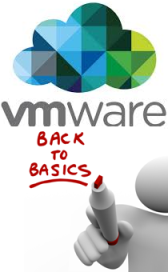This post is continuation for previous post “VMware Basics Part 1”
VMware vCenter Orchestrator:
VMware Orchestrator is a free vCenter feature that helps automate VMware vCloud Suite, vSphere and other virtualization management system processes
vSphere Virtual Symmetric Multi-Processing:
VMware Virtual SMP is a utility that allows a single virtual machine to use two or more processors simultaneously. It allows a single virtual machine to use multiple physical processors at the same time.
vSphere Distributed Resource Scheduler (DRS):
VMware DRS (Distributed Resource Scheduler) is a utility that balances computing workloads with available resources in a virtualized environment.It divides and balances computing capacity for VMs dynamically across collections of hardware resources.
vSphere Storage DRS:
Storage DRS allows you to manage the aggregated resources of a datastore cluster. When Storage DRS is enabled, it provides recommendations for virtual machine disk placement and migration to balance space and I/O resources across the datastores in the datastore cluster. It divides and balances storage capacity and I/O across collections of data stores dynamically.
Storage I/O Control and Network I/O Control:
vSphere’s Storage I/O Control enables segmentation of I/O demands by data store, to enable finer-grained I/O prioritization. Find out how Storage I/O Controls works.
VMware vSphere Network I/O Control (NIOC) allows administrator to set up rules and policies to prioritize bandwidth for different network resource pools on a vSphere distributed switch.
Profile-Driven Storage:
Profile-Driven Storage is a feature in vSphere 5 that lets users to intelligently provision applications, mapping VMs to storage levels according to service levels, availability, performance needs or cost.
vSphere High Availability (HA):
VMware HA feature will restart the Virtual Machines from one ESXi to another when there is a failure occurred. Important point – HA will not use vMotion feature and outage is required for the VM’s to restart on another ESXi host in the Cluster. It allows virtual machines to be restarted on other available servers
vSphere Fault Tolerance (FT):
VMware vSphere Fault Tolerance (FT) provides continuous availability for applications (with up to 4 virtual CPUs) in the event of server failures by creating a live shadow instance of a virtual machine that is always up-to-date with the primary virtual machine. In the event of a hardware outage, vSphere FT automatically triggers failover—ensuring zero downtime and preventing data loss.
Virtual SAN (VSAN):
VMware VSAN (VMware Virtual SAN) is a storage feature integrated in the vSphere 5.5 kernel that pools disk space from multiple ESXi hosts.VMware Virtual SAN is radically simple, hypervisor-converged storage designed and optimized for vSphere virtual infrastructure.
vSphere Replication:
VSphere Replication is a feature of vSphere 5.0 and Site Recovery Manager (SRM) 5.0 that automates the failover of virtual servers to a recovery site. vSphere Replication enables the replication of virtual machines (VMs) at the virtual layer instead of at the storage layer, as was required with earlier versions of vSphere and SRM
Leverage a “seed copy” of virtual machine data during initial synchronization.
Ensure efficient network utilization by tracking changed disk areas and only replicating deltas.
Flash Read Cache:
VMware vSphere Flash Read Cache virtualizes server side flash providing a high performance read cache layer that dramatically lowers application latency. The caching is fully transparent to the VM without requiring any guest agents. Flash Read Cache enables allocation of flash resources at a per-VMDK granularity providing VMware vSphere vMotion consistent read caching and integration with VMware vSphere Distributed Resource Scheduler for initial placement.
